|
This week I would like to share with you the most popular practices from the yoga research protocol. In the 2014 study, intention setting, mudra, pranayama and relaxation were practiced most often at home by the research participants. I have compiled these practices which can be easily incorporated into your own home practice, or be used to start practicing today. SETTING YOUR INTENTION We will begin with an intention setting meditation which guides you through setting a sankalpa (an intention or resolve) for your practice. Once you create your intention, continue to use it before your practice each day. You will repeat the sankalpa three times silently at the beginning of your practice and then call it to mind again at the end of your practice. This repetition plants a seed for self-transformation deep within your mind to assist you on your path towards healing. At some point in the future, you may feel the need to change the sankalpa if it has come to fruition or you are not resonating with it any longer. Then it would be appropriate for you to go through this meditation again. Begin sitting in a comfortable seated position with the palms resting together at the heart. Feel the breath gently directed into the chest which will encourage your deepest wish for self-transformation to arise. Bring to mind the current challenges that you are facing. Without dwelling on the details, recognize that all challenges are opportunities for personal growth and healing. Perhaps your current challenges have already set the stage for transformation in your life. Continue to visualize this challenging situation and hold it within the space of the heart, releasing any feelings of judgment or blame if they arise. Begin to visualize the best possible outcome for the challenges you are facing. If any thoughts of doubt begin to arise, redirect the mind towards receptivity and the positive resolution of your current situation. Whatever steps need to be taken, imagine taking them with self-confidence bringing this outcome into reality. Trust that you have the strength, courage and ability to bring the imagined positive outcome into reality. Be confident that you can create your own reality based on your visualization. Allow your intention to coalesce into a short simple statement phrased in the present tense beginning with the words "I am ...". State it silently three times. Trust that your sankalpa will manifest with patience and repetition and repeat it mentally before each yoga practice.. Take a few more breaths to firmly implant this heartfelt wish into your consciousness.  Stating Your Intention During the first yoga session you will create an intention for your yoga practice. Each time before you practice, sit comfortably with the eyes closed and bring to mind this resolve, state it silently three times with your full awareness. You are welcome to write you intention down if you choose. MUDRAS Mudras are hand gestures that redirect energy and awareness into the body to create specific physical or emotional shifts. Like you would tune a radio to a certain frequency to listen to a particular type of music, you create patterns with the fingers to elicit a particular response in the body. You can practice mudras any time you need to feel a sense of connection to your center.  Adhi Mudra Begin in a comfortable seated position (you may also sit in a chair if needed). Make a soft fist with the thumb tucked inside. Turn palms down and rest the hands on the knees. Intended Benefits: Creates a sense of grounding and reduces anxiety  Uttarabodhi Mudra Clasp hands together and press index fingers together and thumbs together and open the center of the palms. Variation I: Hold hands in front of belly with the sides of the thumbs, heels of the hands and sides of the pinkie fingers against abdomen. Creates a sense of self-nurturance. Variation II: Hold hands in front of heart with the sides of the index fingers and sides of the thumbs against the sternum. Activates the thymus gland to increase immunity. 4-PART BREATH, MUDRA & MANTRA MEDITATION This 4-part breath, mudra and mantra meditation is especially helpful for fostering emotional well-being. It highlights the four natural parts of the breath cycle with a mudra and mantra to allow the mind to be completely absorbed in the practice and can be used whenever you feel the need to reconnect with the life giving energy that each breath offers and with the trust inherent in our true nature.  Avhana Mudra Begin in a comfortable seated position (you may also sit in a chair if needed). Turn the palms up touching the pinkie side of the hands together. Press the bent thumbs into base of index finger and keep the other fingers close together. As you inhale, say mentally "I accept" and draw the hands toward the body. Intended Benefits: Increases ability to receive help from others from others  Samputa Mudra Cup hands right over left creating a hollow space between the palms. During the pause after the inhale, say mentally "I am grateful". Intended Benefits: Acknowledges the gifts you carry within 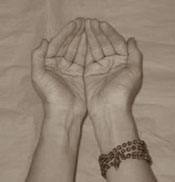 Pushpanjali Mudra Cup hands with little and ring fingertips together creating a offering bowl shape. As you exhale, say mentally "I give" and move hands away from the body. Intended Benefits: Encourages compassion, generosity, giving 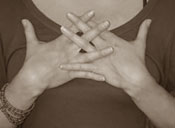 Vajrapradama Mudra Clasp fingers together and open the palms toward heart; point thumbs upwards and hold the hands a few inches away from the heart. During the pause after the exhale, say mentally "I trust" Intended Benefits: Builds confidence, security, and trust BREATHING PRACTICES Bringing conscious awareness to the natural breathing process can have a profoundly relaxing and healing effect on the mind and body. We will practice three techniques here that can be done after your yoga practice or at any time throughout the day; alternate nostril breathing which balances the work of the nervous system, belly breathing which creates a state of peace and calm, and exhale retention which further releases stress and tension. 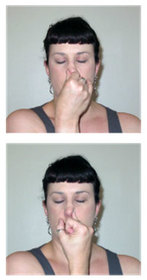 Alternate Nostril Breathing Begin in a comfortable seated position (you may also sit in a chair if needed). Use the right hand and close the right nostril with thumb. Breathe in through the left nostril, the change nostrils by closing the left nostril with the ring finger and breathe out through the right nostril. Breathe back in through the right nostril, then change the fingers again and breathe out through the left nostril. Try to hold the hand directly in front of the face so that you do not have to turn the head. Practice for up to 10 rounds, increasing the number of rounds gently as your comfort level allows. Intended Benefits: Balances the sympathetic nervous system (fight or flight) and the parasympathetic nervous system (rest and digest), increases communication between the right and left hemispheres of the brain. 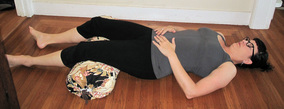 Belly Breathing Lay on the back with support under the head and knees if needed, close eyes and feel the breath moving in and out of your nostrils. Place the hands on the lower belly. Inhale and feel the fullness in the belly, exhale and feel the surrender in the belly. Practice for up to 5 minutes. Intended Benefits: Calms the nervous system, grounds the emotions, and relaxes the body. 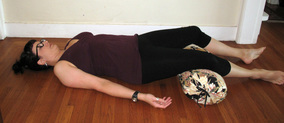 Exhale Retention Lay on the back with support under the head and knees if needed, close eyes and feel the breath moving in and out of your nostrils. Rest the hands on the floor with the palms facing upwards. Inhale into the belly and exhale slowly and completely, extending the length of the exhalation slightly. Begin to rest in the pause after the end of the exhalation for a moment before breathing in. Long slow inhale, longer slower exhale and pause. Practice for up to 5 minutes. Intended Benefits: Calms the nervous system, grounds the emotions, and relaxes the body. FINAL RELAXATION It is important to give yourself a few minutes at the end of your practice to rest in stillness and silence so that the gifts of the practice can be fully integrated into your body and mind. You may stay in the Body Scan posture and rest for as long as you like but be sure to rest for at least 5 minutes. Feel free to set a timer if you are concerned that you might fall asleep. 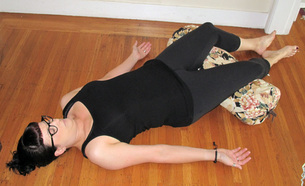 Relaxation Pose Lay on the back with legs straight and feet relaxed to sides. Move arms away from sides slightly and turn palms to face the ceiling. You may use support under the knees for low back pain; and a folded blanket under the head if needed. Rest at least 5 minutes. Intended Benefits: Allows for integration of mind and body after asana practice, promotes restful awareness
0 Comments
|
Index:Archives:
September 2022
I attend Cheryl's class regularly and feel that my practice has improved immensely over the past few years due to her expert coaching. Her teaching style is clear and compassionate and her previous experience in teaching adults is evident in her organized approach and easy to understand instructions. I also appreciate that Cheryl not only teaches us about how to correctly position ourselves, but also touches on many aspects of yoga philosophy, which in turn has deepened my personal practice and heightened my awareness of the connection between mind and body, breath and relaxation. |

 RSS Feed
RSS Feed
